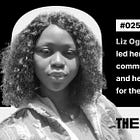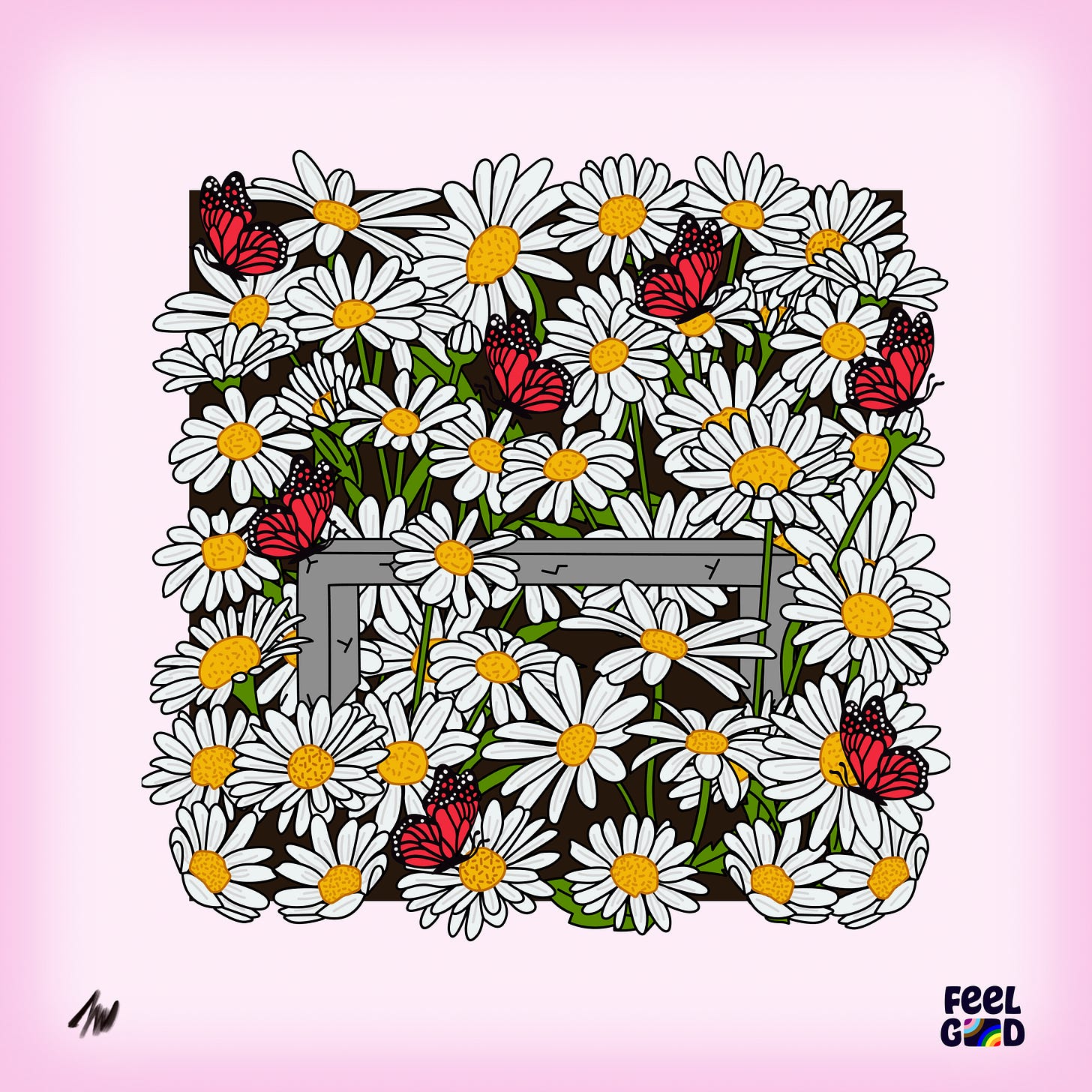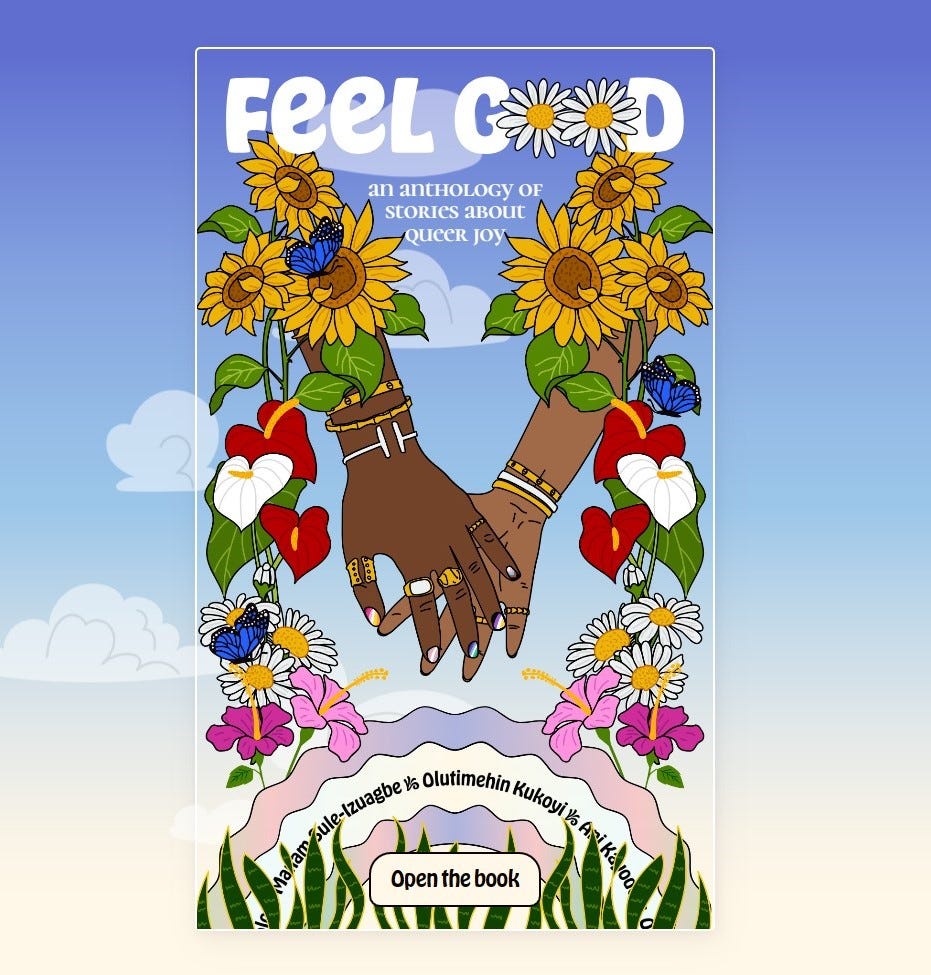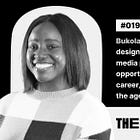“I really love how it turned out”—Ife Aminu on Feel Good's flower-inspired illustrations
In a conversation with The Creatives Note, Ife Aminu talks about getting to create the illustration for Feel Good and how the illustration added more delight to the stories.
In 2023, Wuruwuru, a collective for independent creators, published Feel Good, an anthology of short stories written by some of Nigeria’s most gifted and thoughtful queer storytellers.
The project—curated by Daniel Orubo and Opemipo Aikomo, who recently left his role as head of design at Paystack—contains eight stories that explore the nuances of queerness through a Nigerian lens, imbuing each narrative with an air of hopefulness. “This project was born out of the desire to see more joyful representations of queer life in the media,” they note. “Too many mainstream queer stories end in tragedy, but Feel Good seeks to offset that troubling pattern by telling tales where our queer protagonists find love, family, and healing.”
One of the captivating things about the project is the website and cover illustrations for the stories. The website—created by Studio Null, a digital experience studio run by Isaac Fayemi and Seyi Oluwadare—presented the stories in a fun and refreshing format, while the illustrations—created by Ife Aminu, an illustrator and graphic designer—added more delight to the story.
Related
In a conversation with The Creatives Note, Ife Aminu talks about getting to create the illustration for Feel Good, how she approached the brief and how the illustration added more delight to the stories.
“[We] need something that would capture the stories better”
“I got a LinkedIn message from Isaac Fayemi, partner at Studio Null, telling me there's a project he thinks I will be a very good fit for,” Ife tells The Creatives Note. Prior to this message, she had only met Isaac once—at a conference where they said hello to each other, with him mentioning that “he would love for us to work together on a project. But I didn’t think much into it,” she notes.
So when she got the message, she responded and they set up a call. “On the call, he told me about the project and mentioned that it’s for a queer project and if it’s something I would be interested in,” she shares. “I was a little bit apprehensive at first but I took it on.”
According to Isaac, they had gone far into the website design but they needed someone who could illustrate flowers. “He said they had something but it was not working so he needed something that would capture the stories better and he thought that my style would suit what they were trying to go for better,” Ife tells The Creatives Note.
My deliverables, Ife says, were cover illustrations for each story, an end-of-story illustration that is significant to the story, and a cover for the entire book—that is, the homepage.
Finding inspiration in flowers
“To begin with, I was sent the eight stories to read,” Ife tells The Creatives Note. “I remember being really impressed when I read the first story—A bookish affair.”
She notes that she read all the stories again and again. And after reading them well enough, she came up with a timeline and drew a plan for how the project will go from beginning to end. “Afterwards, I took to Pinterest and every other platform I could find to source for inspiration and references,” she explains. “I was looking for how flowers are depicted, and I saw a bunch of really nice stuff.”
Read Also
After finding some interesting references, she came up with a mood board. “The mood board contained flower suggestions,” she notes. “I wrote initial thoughts for each story and the direction that I thought each story could take in terms of the flower I thought would suit the story.”
She adds, “I came up with two documents that I shared with the team. One was the initial thoughts on creative direction, and the second one contained the composition of the layout and style of the flowers.”
After sharing the documents, she got a green light from the team and got to sketching. “I got the go-ahead of the team and it was time to illustrate,” she shares. “So I did a sketch of my initial ideas for each story.”
The choice for the flower to illustrate for some of the stories, she says, was just random and for others, “it was based on my experience and what I felt at the time of reading the story.”
For example, for ‘In The Jungle’, she chose Birds of Paradise because it felt right, while for ‘Feria’s Story’, she chose Orchid because the writer mentioned it in the story, but eventually had to choose another flower because, “apparently, orchid cannot stand on its own so it was hard for me to illustrate it,” she shares, noting that she had to change some of her initial ideas.
“The most profound story for me was ‘A Bookish Affair’. The story was set in Abeokuta and it reminded me of Bougainvillea,” Ife tells The Creatives Note. “Bougainvillea was the first flower that came to my mind when I read the story. And funny enough, the week before that, I saw the flower close to my house when I was taking a stroll. [Seeing it that day] reminded me of the neighbourhood I grew up in because we had them there.”
“For ‘Keep It For My Sake’, I used Cala Lily,” she notes. “For ‘Sink and swim’, I used Montsera because the author mentioned it in the story.”
She continues, “For ‘Wake Me Up When Love is Enough’, I used Hibiscus because the story reminded me of Purple Hibiscus.”
“For the ‘House of Akwusianubaogu’ story, I saw the plant and thought it would suit the story. So it's a bit hard to explain because there are some things that just sort of fit together. You just get the sense in your head that it fits and if it doesn’t fit, you will know,” she shares. “So I just went with my gut and instinct.”
Read Also
Sticking to the composition and layout
In addition to the flowers, the cover features an object central to the story in the middle. “For the composition and layout, we (Isaac and I) agreed that we would have the flower and an object that is central to the story in the middle,” she recalls. “It was simple so I stuck with it.”
After sketching the flowers, she set out to sketch the central object as well. “For ‘House of Akwusianubaogu’, I added a Gong [Ndi Ogene] because there was something about it in the story,” she shares.
“For ‘A Bookish Affair’, I added a tote bag because I remember a family member who had gone to the Ake Festival—where the story was set—coming back with a tote bag and books from the festival. So I drew from a personal experience for that story.”
The guitar used in the ‘Keep This For My Sake’ cover, she says, was inspired by Thomas Sankara’s wine-red and white guitar, which the story mentioned.
For ‘In The Jungle’, a story of two agberos, she says, she got the inspiration for the hand from the famous Michelangelo’s Creation of Adam painting. “I just used weed and lighter to tie the story together,” she adds.
For ‘Feria’s Story’, she referenced the Stone Bench mentioned in the story. “I just put the stone bench at the centre with the leaves growing around it,” she explains. “I also added butterflies because it was mentioned in the story.”
“For ‘Sink and Swim’, I chose a window, a plant and a balcony,” she shares.
For ‘The Mathematics of Hooking Up’, she notes that she initially chose Crown of Thorns because the story was a bit tragic and still beautiful, but later changed it. “I changed it to Sunflower and added Ice cream because it was mentioned in the story,” she explains.
Bringing everything together
Once she was done with the sketches, she shared them with the team again. “Afterwards, I went ahead to illustrate them on Procreate before moving to Illustrator,” says Ife. “I developed the sketches into the final output we have now.” For most of them, she stuck to the initial ideas but for some, she says she changed and tweaked them.
For example, she mentioned that she changed the sketch with Orchid because it was hard to draw. “I feel like, after the human hand, the orchid is the next toughest thing to draw,” she says.
Read Also
For the end-of-story illustrations, she picked and illustrated things from the story. “People who read through the story will get it,” she notes.
The final thing she had to work on was the home page cover. “It took me like a week or two to figure it out,” she reveals. The formula she employed for the final cover, she says, was to pick one thing from each story and combine them.
The final cover, she notes, is also inspired by how expressive queer people are. “The hand has colourful pieces of jewellery because I feel like queer people are characterised by how very expressive and colourful they are in terms of accessories and how they present themselves,” she explains. “They wear nose rings, colourful hair, and jewellery.”
The colour of the nails, she says, is inspired and taken from the colours of the different LGBTQ flags, “because each [queer] group have their flag and colour,” she notes. “That’s why the nail colours are different.”
She adds, “For the background, I was going to go with black but it was boring, so I got on a call [with Isaac] to figure out a gradient that worked for it.”
Once she was done with the illustration, Ife says, she presented the final output to the general team and they loved it. “I showed them the output and how we arrived at what we had and they just loved it instantly,” she shares. “I was really happy with the response.”
“We (Isaac and I) knew we had done a great work but hearing them say how much they love it was good to hear.”
“I really love how it turned out”
“This is my favourite project from 2023,” Ife tells The Creatives Note. “It was just so fun. I really love how it turned out.”
“There’s something about doing work that is tangible,” she says, because “You can see people interacting with it online.”
Read Also
The illustration just brought life to the entire story, Ife tells The Creatives Note. “The project was challenging. I had never done anything like this before. I took up the project to challenge myself and it did exactly that,” says Ife, adding, “I feel grateful that I am able to apply my work in this kind of medium.”
The reception since the project launched, she says, has been so great. Even though Ife thinks she doesn’t have a style, she notes that she has had people “who didn’t know I worked on it sharing with me saying this looks like my work and something I would do,” she says. “Apparently I have a style.”





























